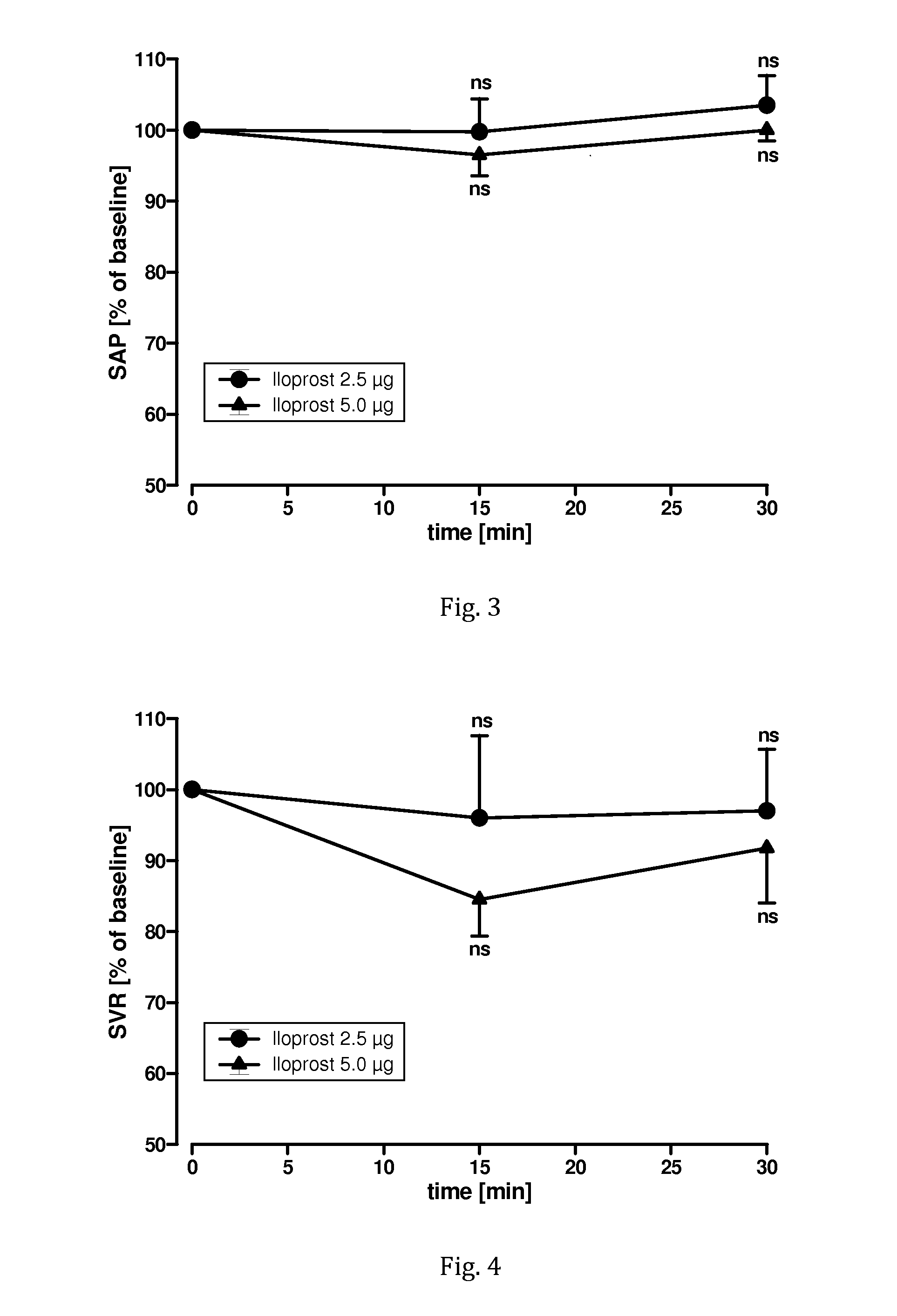Administration of iloprost as aerosol bolus
a technology of iloprost and aerosol, which is applied in the direction of aerosol delivery, drug composition, dispersed delivery, etc., can solve the problems of increased blood pressure in the pulmonary circulation, severe and potentially life-threatening diseases, and pulmonary hypertension, and achieves high output rate and high efficiency
- Summary
- Abstract
- Description
- Claims
- Application Information
AI Technical Summary
Benefits of technology
Problems solved by technology
Method used
Image
Examples
example 1
[0075]In an in vitro nebulisation study, the feasibility of delivering aerosolised single doses of 2.5 μg and of 5 μg of iloprost to the mouthpiece of a nebuliser was evaluated. A nebuliser system comprising an electronic vibrating mesh nebuliser (by PARI GmbH, incorporating the Touchspray Technology®; having some similarity to PARI's eFlow® nebuliser) and a device for controlling the breathing pattern (AKITA®) was configured by means of an electronic chip card to deliver an aerosol from an aqueous solution at a flow rate of 15 L / min. The inhalation system is also known as AKITA2 APIXNEB™ (by Activaero GmbH). For the purpose of enabling the control of the breathing pattern of a patient using the AKITA2 unit, the nebuliser handset device in the APIXNEB™ system differs from the eFlow® system by modifications allowing it be connected to the AKITA2 unit through an electric cord and an additional tube for providing e.g. a predetermined inspiratory air flow. Further details on the device ...
example 2
[0079]In an in vitro nebulisation study, the feasibility of delivering aerosolised single doses of 2.5 μg and of 5 μg of iloprost by bolus inhalation according to the invention using three different inhalation devices and two different aqueous iloprost formulations was evaluated. The two tested formulations were the commercially available Ventavis® inhalation solutions 10 μg / mL and 20 μg / mL, respectively. At the same time, the resulting aerosol characteristics in terms of particle (droplet) size were determined.
[0080]The first inhalation device (A) was an AKITA2 APIXNEB™ system as described in Example 1. The system was configured to provide an inspiratory flow rate of 15 L / min. The duration of each inhalation phase was 5 seconds, which period was divided into a nebulisation phase of 4 seconds immediately followed by a period of 1 second in which aerosol-free air was emitted. The duration of each exhalation phase was set as 5 seconds, so that the total duration of each breathing mano...
example 3
[0092]A clinical pilot study to evaluate the safety and tolerability of nebulised iloprost administered by bolus inhalation according to the invention was conducted with 4 patients. Eligible were male and female patients with pulmonary arterial hypertension in the age from 18 to 70 years having a mean pulmonary arterial blood pressure (PAP) higher than 25 mm Hg, a pulmonary vascular resistance (PVR) higher than 240 dyn*s*cm−5, a central venous pressure (CVP) higher than 3 mm Hg, and a pulmonary capillary wedge pressure (PCWP) lower than 12 mm Hg.
[0093]Excluded were patients with a contraindication for cardiac catheterisation (such as coagulopathy, bleeding disorder, acute infection, severe cardiac dysrhythmia), pregnancy, systemic systolic blood pressure below 110 mm Hg, highly impaired ventricular function with cardiac index below 1.8 L / min*m2, and known lack of pulmonary vascular reactivity.
[0094]Patients were monitored by ECG, pulse oxymetry, and non-invasive blood pressure measu...
PUM
| Property | Measurement | Unit |
|---|---|---|
| pH | aaaaa | aaaaa |
| pH | aaaaa | aaaaa |
| pH | aaaaa | aaaaa |
Abstract
Description
Claims
Application Information
 Login to View More
Login to View More - R&D
- Intellectual Property
- Life Sciences
- Materials
- Tech Scout
- Unparalleled Data Quality
- Higher Quality Content
- 60% Fewer Hallucinations
Browse by: Latest US Patents, China's latest patents, Technical Efficacy Thesaurus, Application Domain, Technology Topic, Popular Technical Reports.
© 2025 PatSnap. All rights reserved.Legal|Privacy policy|Modern Slavery Act Transparency Statement|Sitemap|About US| Contact US: help@patsnap.com


